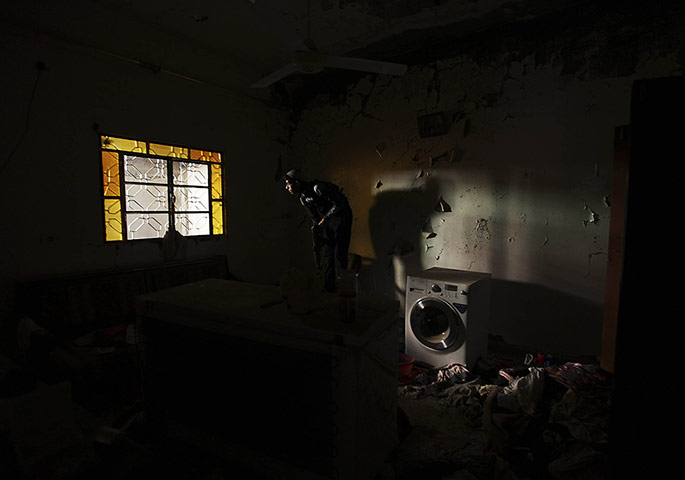There is an art to taking photographs of artifacts or artworks in a museum. Think of all the images you’ve seen in photography books or magazines or newspapers–and how you didn’t even think of the fact that they were photographs–or of how those snaps you took with your camera didn’t turn out so well. It takes skill to put art into circulation. Even so, there is little reason not to take it for granted, and in any case photography’s most important museum is found outside the gallery walls.
But not necessarily outside. This dark interior contains no light of its own, as if it were a cave. The weak shaft of light seems to have to bend to get there, as if refracted along canyon walls before entering this animal’s den. The animal seems to be human, although his shadow looks like a rat, and that feral insinuation might be closer to the truth of his circumstances.
The caption says, “A Free Syrian Army fighter takes position inside a house in Deir al-Zor.” One could almost say, “what had been a house.” The place seems to be returning to darkness, to an inchoate void that soon will absorb everything there. Imagine how much has been lost already. Walls that will have been decorated and echoed with conversation and laughter now are pockmarked from destructiveness. What had been a table or chair now is the soldier’s stepladder. What appears to be clothing and other domestic goods are piled on the floor, thrown perhaps because they couldn’t be taken to a refugee camp, or so they wouldn’t be in the way of the fighting. Whatever the story, it’s one of lives being undone.
And so we get to the washing machine and the window. Each is remarkably salient, each has a presence as if it were something uncanny, each is both where it is supposed to be and yet dramatically out of place. In other words, each now has the properties of a work of art. The machine stands there like a surrealist found object, a machine of domesticity framed as a thing in itself, or perhaps as a historical curio–say, a Soviet capsule intended to send a monkey into space. Such options are far-fetched, but compare them with the impossibility of the washer simply being what it was: a banal part of ordinary life.
And that window! Was it ever banal? Perhaps there are many like it, and on close inspection it looks like a machined knockoff of merely decorative designs. But still, it is at once beautiful and so vulnerable. You can’t believe that any soldier on any side in this street fight is going to hesitate to shoot through it the second they see a target. And such a shame, as the stained glass and abstract pattern resonate across art history, sacred and secular, from Gothic cathedrals to Islamic calligraphy to modern art. Of course, it was just a nice window in someone’s house, admired occasionally and ignored much of the time, but that’s how a good society works. When ordinary life is well above the level of living in a cave, it’s because ordinary things are continuous with so many fundamental achievements in art, science, government, and the other arts of civilization.
If a tank fires, the entire room will be obliterated. At that point, all that will remain of these remarkable works of art will be the photograph. I’ve said recently that photography can provide an archaeology of the present: the images that would remind us of how close we can be to becoming ruins. We could also say that photography is creating a virtual museum: a vast, continuously unfolding gallery of those things that are already becoming part of the past. Ordinary things that are becoming precious, useful things that are becoming junk, sentimental things that now can only be the set up for irony.
This is the best kind of museum photography, precisely because it is there to document lost civilizations that still have a chance of survival. In Syria’s case, much already has been lost to the darkness. There is still time, perhaps, to find a way peace and the restoration of something like a normal life for the millions currently suffering from the civil war. What seems to be lacking is a sense of urgency. Perhaps it might help to take a walk through photography’s museum. Take another look, and ask yourself if any part of the present is as secure as it might seem.
Photograph by Khalil Ashawi/Reuters.

[…] See on http://www.nocaptionneeded.com […]